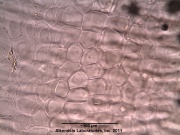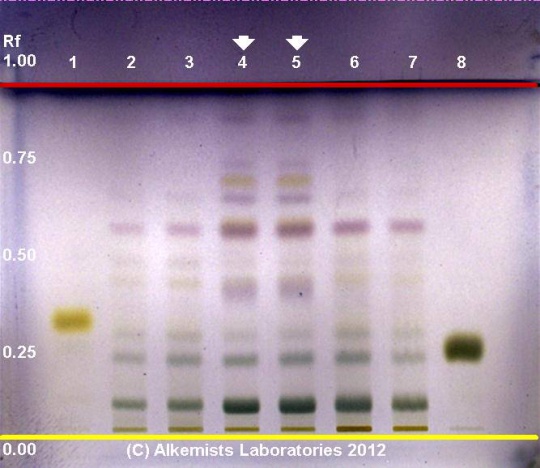Plantago ovata (seed husk)
(Nomenclature updated) |
(Various title corrections, Source additions) |
||
| Line 1: | Line 1: | ||
| + | {{DISPLAYTITLE:''Plantago ovata'' (seed husk) }} | ||
=Nomenclature= | =Nomenclature= | ||
| Line 11: | Line 12: | ||
|notes=The standard common name of the seed of P. ovata and other species of Plantago is psyllium. }} | |notes=The standard common name of the seed of P. ovata and other species of Plantago is psyllium. }} | ||
| − | =Macroscopic | + | =Botanical Voucher Specimen= |
| − | =Microscopic | + | =Organoleptic Characteristics= |
| + | |||
| + | =Macroscopic Characteristics= | ||
| + | =Microscopic Characteristics= | ||
{{Microscopy | source=Elan M. Sudberg, Alkemist Laboratories | {{Microscopy | source=Elan M. Sudberg, Alkemist Laboratories | ||
| Line 27: | Line 31: | ||
| − | = | + | =High Performance Thin Layer Chromatographic Identification= |
{{HPTLC | source=Elan M. Sudberg, Alkemist Laboratories | {{HPTLC | source=Elan M. Sudberg, Alkemist Laboratories | ||
| description=Psyllium (husk) (''Plantago ovata'') | | description=Psyllium (husk) (''Plantago ovata'') | ||
| Line 54: | Line 58: | ||
| }} | | }} | ||
| − | = | + | =Supplementary Information= |
| + | =Sources= | ||
| + | <references /> | ||
Revision as of 02:01, 16 March 2014
Contents |
Nomenclature
Plantago ovata Forssk. Plantaginaceae
Syn. Plantago ispaghula Roxb. ex Fleming
Standardized common name (English): Indian plantain
Botanical Voucher Specimen
Organoleptic Characteristics
Macroscopic Characteristics
Microscopic Characteristics
|
High Performance Thin Layer Chromatographic Identification
|
Psyllium (husk) (Plantago ovata) Lane Assignments Lanes, from left to right (Track, Volume, Sample):
Stationary Phase Silica gel 60, F254, 10 x 10 cm HPTLC plates Mobile Phase ethyl acetate: glacial acetic acid: methanol: water [6/1.5/1.5/1] Sample Preparation Method 0.3g+3mL 70% grain EtOH sonicate/heat @~50° C ~ 1/2 hr Detection Method Vanillin/H2SO4 Reagent-> 110° C 5 min -> visible light Reference see Method Developed by Alkemists Laboratories
|
Supplementary Information
Sources
- ↑ Elan M. Sudberg, Alkemist Laboratories http://www.Alkemist.com
- ↑ Elan M. Sudberg, Alkemist Laboratories http://www.alkemist.com


